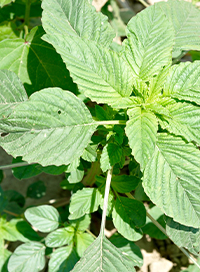 Until about a decade ago, Palmer amaranth was relatively unheard of in the Midwest. Since then, the pigweed has made a name for itself as one of the most competitive weeds in cornfields spanning several states. It can devastate corn yield.
Until about a decade ago, Palmer amaranth was relatively unheard of in the Midwest. Since then, the pigweed has made a name for itself as one of the most competitive weeds in cornfields spanning several states. It can devastate corn yield.
Palmer amaranth is known for its long emergence, rapid growth, prolific seed production and ability to develop resistance to herbicides. These are just a few of the reasons the weed is so difficult to control and why farmers need to be on the lookout for it.
What You Need to Know
Palmer amaranth, known by its scientific name Amaranthus palmeri is a late-summer annual plant that often emerges well after typical postemergence herbicide applications.
The weed has recorded resistance to five different herbicide groups.1 Although it is native to the southwestern United States, resistant populations of Palmer amaranth have been found in 27 states, including Illinois, Indiana, Kansas, Missouri, Michigan, Nebraska, Ohio and Wisconsin.
Palmer amaranth is dioecious, meaning the male and female plants are separate. This allows the weed to have greater genetic diversity and to more easily develop herbicide resistance. A single female Palmer amaranth plant will produce an average of 600,000 seeds. The plants can also grow very quickly, up to 2.5 inches in one day.1
These traits combine to make the weed one of the most competitive in cornfields. If left to flourish, Palmer amaranth can decimate corn, reducing yield by up to 90%.2
What to Watch For
Knowing how devastating Palmer amaranth can be, it’s important you know what to look for.
One challenge, however, is telling the pigweed apart from its cousins like waterhemp and redroot pigweed. Here are characteristics that can help you identify Palmer amaranth:3
- The leaves tend to be wider and ovate to diamond-shaped.
- The stems are smooth and hairless.
- The petioles will be as long or longer than the leaf blades themselves.
- The terminal seedheads on female Palmer amaranth plants can grow up to 3 feet long and will feel prickly.
- Some leaves have a white, chevron-shaped watermark.
How to Control Palmer Amaranth
You should always use a herbicide program approach to control Palmer amaranth. This means using a burndown and then a preemergence residual such as SureStart® II herbicide or Resicore® herbicide followed by a postemergence application of a chemistry such as Realm® Q herbicide. Find other solutions that can help control the pigweed on the Corteva Agriscience Corn Herbicides portfolio page.
Palmer amaranth can emerge long after a postemergence application, so you should add some cultural practices to your weed control program. Some of those practices include crop rotation and deep tillage, where possible. Cover crops also can help. Cereal rye, for example, can provide a mulch that will suppress Palmer amaranth emergence.3
In addition to those steps, it’s recommended to harvest any fields with the weed last to prevent spreading it to unaffected areas. You can also consider hand-weeding Palmer amaranth in-season and then burning the plants to keep the weeds from getting back into the fields.
Palmer amaranth is a relatively new and very difficult weed. But by better understanding it, you can control it and protect your corn yield.
1United Soybean Board. 2020. Waterhemp. https://iwilltakeaction.com/weed/common-waterhemp.
2Hager, A. 2018. Remain Vigilant for Palmer Amaranth. https://farmdocdaily.illinois.edu/2018/07/remain-vigilant-for-palmer-amaranth.html.
3Legleiter, T., and B. Johnson 2013. Palmer Amaranth Biology, Identification and Management. https://www.extension.purdue.edu/extmedia/ws/ws-51-w.pdf
Realm® Q, Resicore and SureStart® II are not registered for sale or use in all states. Resicore and SureStart II are not available for sale, distribution or use in Nassau and Suffolk counties in the state of New York. Contact your state pesticide regulatory agency to determine if a product is registered for sale or use in your state. Always read and follow label directions.
The More You Grow
Find expert insights on agronomics, crop protection, farm operations and more.